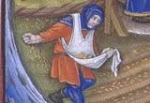When I’m done writing this post, I’ll be going out to “toil in the fields,” the phrase we throw around the house to mean that I’m going to work in the garden.
Last year I planted a small plot, about 115 square feet of red spring wheat. This year, using the fruits of that field, I’m going to plant a much larger plot of about 600 square feet.
 The 'before' picture
The 'before' pictureLast year, I prepared that plot in the spring by mowing the grass short, covering the area with newspaper, spreading manure and topsoil over the paper and planting onto that. That technique was neither historical nor did it work particularly well. The weeds were able to push through the newspaper, the wheat roots were unable to penetrate the newspaper and firmly anchor themselves and a nearby tree seemed to create a shadow over about a third of the plot that little grew in.
So I wanted to try something different. What I
wanted to do was to plow, but that was unrealistic because of the small area that I do have and the costs associated. So, I decided to do the next best thing: Double Dig.
What is double digging? Essentially, you’re turning the soil by hand. You dig a trench and set that earth aside. Then you dig another trench the same size, adjacent to the first, filling the first trench with the dirt. You keep doing that over the entire plot until you’re left with just a trench, and then you fill that hole with the dirt you set aside from the very first trench.

 The initial trench
The initial trenchIt does several things. First it turns the soil. The sod from the top of each fresh trench goes in the
bottom of the trench (and I’ve been being very careful to deposit the sod upside down) and is then covered by 8-10 inches of dirt. It loosens the soil and de-compacts it, making it more suitable for planting. And thirdly, it plows under the grass, allowing those nutrients to return to the soil.

 The second trench and the filled first trench
The second trench and the filled first trench
Is it historical? I don’t know. Nothing I have read so far has mentioned it, but I have yet to read anything that specifically discusses Medieval or Iron Age agricultural techniques. I suppose that is a huge oversight on my part and I should really do that before next year. But, there is nothing about the technique that couldn’t have been done, since all it requires is a shovel and a strong back. And a lot of time.
It is very slow though, at least for my city-living, unathletic, desk-job of a physique. It tales about an hour to do two trenches, each 18” wide and 15 feet long. The first day I put in four hours straight of work and it left my arms and back aching for several days after. Since then, in between bouts of bad weather and the holidays, I’ve been putting in an hour here or there and today I should get to the halfway point.
 Three trenches
Three trenchesMy experiences? It’s hard work, but I enjoy it. Maybe it’s the novel aspect of it, but I’d much rather be digging than running on the treadmill. It does strain my 40-year old back, which is probably good for it. I do wonder how historical it might be in this one area: I have read in several places that wooden tools were the norm for the Early Middle Ages. Even if those wooden shovels were iron shod, I am a little dubious that they could withstand the abuse that I throw at my steel one. Stomping on it to cut through the sod, jamming it into the dirt, prying/lifting the heavy, damp soil . . . The wooden handle has survived so far, so maybe, but I don’t know. It does at least make me wonder.
 Near the end of that first, four-hour day. Six or seven trenches.
Near the end of that first, four-hour day. Six or seven trenches.OK, so off to work. But before I go, here’s two pictures of me, in my costume, toiling in the fields.



















